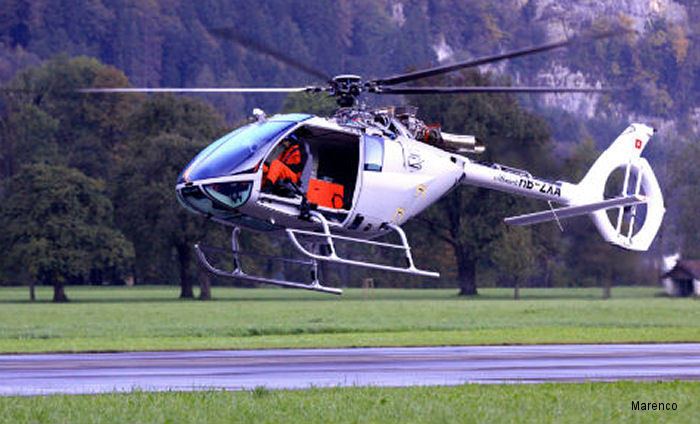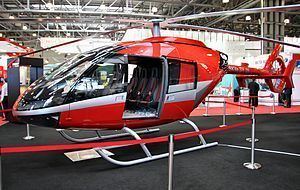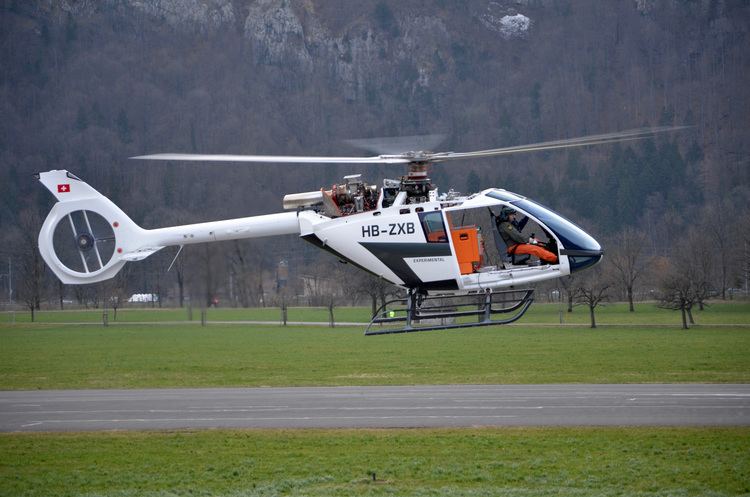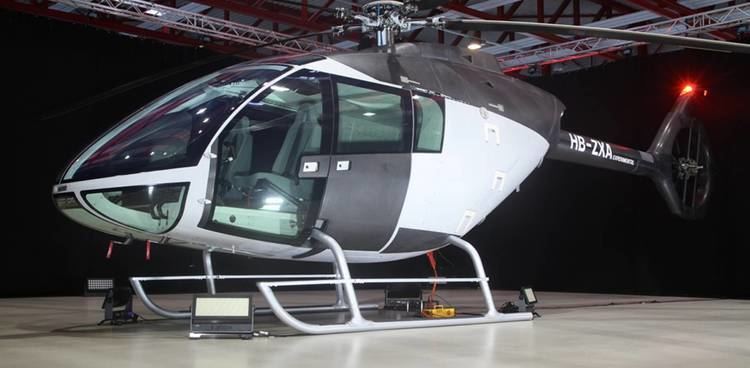Length 10 m First flight October 2, 2014 | Manufacturer Marenco Swisshelicopter | |
 | ||
The Marenco Swisshelicopter SKYe SH09 is a Swiss five to eight seat, single-engine utility helicopter which is currently under development by Marenco Swisshelicopter. It is promoted by Marenco as being a clean-sheet design amongst a market sector dominated by decades-old airframe designs.
Contents
The design first flew on 2 October 2014.
Origins

In 2002, Martin Stucki, a mechanical engineer and commercial helicopter pilot, initiated design work on what would eventually become the basis for the SKYe SH09. Frustrated by legacy designs and typically unsuited cockpits, Stucki had observed that the light single-engine helicopter market had not seen any all-new designs developed in decades, and conducted market research that indicated a viable demand for a new rotorcraft in the 2.5-tonne class. Accordingly, in 2007, Stucki formed Marenco Swisshelicopter (the name Marenco was derived from Martin Engineering and Consulting) to carry out the development of the envisioned rotorcraft.

As a clean-sheet design, the SH09 adopted several modern features, including an airframe that is entirely composed of carbon composite materials, a shrouded fenestron tail rotor, and a high-visibility cockpit. The use of carbon composites is a key feature of the aircraft, which has been credited with enabling the high volume cabin to be adopted without incurring too much weight; according to Mathias Senes, Marenco's chief commercial officer: "There’s no other material today that brings the benefits of rigidity, strength, and light weight". According to Stucki, the rotorcraft is designed around the perspective of pilots and this has driven many design attributes, principally those involving the cabin, to improve ergonomics, comfort, and operator requirements overall. In terms of flying capabilities, it possesses excellent hot and high performance, lengthy flight endurance, a low noise signature, and has relatively smooth handling.

By 2009, sufficient financing had been secured from investors, which allowed for the SH09 to be formally launched that year; accordingly, the helicopter was given the designation SKYe SH09 in reference to the year that development on the project officially commenced. A small number of staff worked on the project, initially being a team of nine; an emphasis was made on recruiting very high quality engineers, including from other rotorcraft manufacturers such as Airbus Helicopters; the company had over 100 employees in 2016. Company operations in Switzerland have been split between the towns of Pfäffikon, where is where design work is centered, and Mollis, at which assembly and flight testing operations is conducted; a third facility in Germany is tasked with compliance verification so that the SH09 can easily achieve its type certificate from the European Aviation Safety Agency (EASA).

In March 2011, a pre-production prototype of the SH09 was publicly displayed at Heli-Expo 2011 in Orlando, Florida for the public introduction of the rotorcraft. During the event, Marenco representatives stated that the firm intends to make its first deliveries in 2015, and that it would produce as many as 15 SH09s within the first year as well as potentially rising to 30 rotorcraft in the following year. It was also stated that, while the Honeywell HTS900 turboshaft engine had been selected as the initial powerplant for the SH09, it was hoped that customers would soon be offered a choice in engines.
Prototypes

The flight test program is to involve a total of three prototypes, designated P1, P2, and P3. The first prototype, P1, performed early test flights during the first phase of the flight test program, during which the handling and attitude of the aircraft were explored and the flight envelope gradually expanded, including autorotation tests and being flown at up to 97 per cent of its maximum internal load takeoff weight. P2 and P3 are the main vehicles for airworthiness certification testing; they are more representative of production aircraft, their design incorporating several refinements that had been made based upon experiences with P1. Following on from EASA certification, Marenco aims to quickly achieve Federal Aviation Administration (FAA) certification for the North American market as well. Completion of P1 was reportedly delayed by as much as six months due to the late delivery of its engine by Honeywell. In December 2013, the completed P1 was revealed to the public.
On 2 October 2014, P1 achieved a milestone for the project when it conducted its maiden flight from Mollis Airport. This first flight, lasting 20 minutes, was flown by chief test pilot Dwayne Williams. Stucki announced that the first flight had confirmed preliminary flight characteristics of the SH09. Commenting shortly after P1's maiden flight, the company stated that it was on schedule to receive EASA certification within the next 12-16 months. In summer 2015, Marenco halted flight tests after 100 flight hours to focus on producing the second prototype, P2, which incorporated a modified bearingless rotor head and new rotor blades to reduce vibrations. By September 2015, it was recognised that the original development timeline had been optimistic and that certification would take longer to achieve than had been originally announced. On 26 February 2016, P2 performed its first flight, piloted by new chief test pilot Richard Trueman. At this point, certification was expected to be achieved near to the end of 2016 or during early 2017.
In May 2016, it was reported that Mareno were increasing the pace of the flight test program, that P3 was to be completed within that year, and also that the company believed that type certification should occur during 2017. Marenco had 70 Letters of intent in autumn 2015 and 90 in spring 2016, half of them from North America. In September 2015, a company spokesperson stated that Marenco expects to be producing between 40-100 aircraft per year. That same month, it was also revealed that the firm was currently considering perusing the development of a twin-engine version of the design. In late 2016, Stucki stated that some flexibility to allow for the future adaption of the SH09 to become a twin-engine helicopter had already been incorporated into the base design, and indicated that a twin-engine variant was a straightforward progression.
In October 2016, Stuki acknowledged that P3 would be completed in early 2017, and that certification would likely to occur within 2018, although 2017 may still be possible if further development proceeds smoothly. Development has been delayed by factors such as Marenco having to design and manufacture not only the helicopter itself, but also supporting tools such as test equipment.
Design
The SH09 is a light-medium helicopter, powered by a single Honeywell HTS900 turboshaft engine. It uses a shrouded fenestron tail rotor and the main rotor features a five-bladed bearingless hub; the shrouded tail rotor has a wider diameter and a thinner chord in order to increase airflow, while design aspects such as a narrow tail boom, swept-back tips on the main rotor blades, and the shrouded tail rotor purposefully reduce the SH09's noise signature. The HTS900 is capable of providing 1,020-shaft-horsepower, which is reportedly enough to produce high performance levels for the SH09 under hot and high conditions.
The monocoque fuselage is composed of composite materials and is equipped with sliding side doors on either side along with a rear clamshell door; an atypical feature of the fuselage is the presence of a series of floor-mounted windows between the pilots seats for additional vertical visibility. Some of the composite materials used have been produced using out of autoclave composite manufacturing from suppliers such as TenCate and Gurit. According to Marenco, inspiration for the fuselage's design was drawn from the automotive industry. It has been stated that the firm has sought to introduce the cabin volume of medium-sized twin-engine helicopters to the single-engine market.
The SH09 is offered with various different layout configurations; the default of these options has a total of four passenger seats present in addition to a pair in the front for the pilots, all of which are fully adjustable in height and length. In a high density configuration, five seats are installed in the rear position along with two more passenger seats inline with the pilot's own, which loses the option of the floor window. The use of Kevlar-threaded crashworthy fuel tanks, which are built into the wall and floor of the cargo hold, freed up space to allow for fully adjustable passenger seats in the cabin. The cargo hold is sized to accomidate 10 items of baggage, while the fuel tanks are sized to provide for an endurance of nearly five hours. The rear clamshell door and high-mounted tail boom is thought to potentially be attractive to North American-based air ambulance operators.
The cockpit of the SH09 is designed to provide pilots with a generous field of view and simplify the act of operating the rotorcraft. A Sagem-built ICDS-8A glass cockpit suite is an integrated part of the SH09's standard avionics and instrumentation package. The rotorcraft has been designed with a condition-based maintenance policy, specifying that there should be no time between overhaul (TBO) limits on its various components and systems, including the engine; instead, maintenance is performed based upon condition, which is continuously monitored at all times by an onboard health and usage monitoring system (HUMS). Ease of maintenance and access to systems was an active consideration during the design phase, aiming to deliver lower overall maintenance costs.
Operational history
In March 2016, it was announced at Heli-Expo 2016 that Swiss operator Air Zermatt would serve as the SH09's launch customer.
Specifications (SKYe SH09)
Data from AIN Online
General characteristics
Performance
